
The Heliconiinae, commonly called heliconians or longwings, are a subfamily of the brush-footed butterflies. They can be divided into 45–50 genera and were sometimes treated as a separate family Heliconiidae within the Papilionoidea. The colouration is predominantly reddish and black, and though of varying wing shape, the forewings are always elongated tipwards, hence the common name.
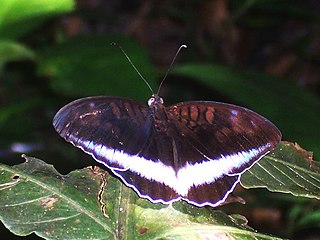
The Limenitidinae are a subfamily of butterflies that includes the admirals and relatives. The common names of many species and genera reference military ranks or – namely the Adoliadini – titles of nobility, in reference to these butterflies' large size, bold patterns, and dashing flight. In particular, the light stripe running lengthwise across the wings of many Limenitidini has reminded earlier authors of officers' shoulder marks and epaulets.

The subfamily Theclinae is a group of butterflies, often referred to as hairstreaks, with some species instead known as elfins or by other names. The group is part of the family Lycaenidae, the "gossamer-winged butterflies". There are many tropical species as well as a number found in the Americas. Tropical hairstreaks often have iridescent blue coloration above, caused by reflected light from the structure of the wing scales rather than by pigment. Hairstreaks from North America are commonly brown above. Few Theclinae are migratory. Members of this group are described as 'thecline'.

The Eumaeini are a tribe of gossamer-winged butterflies. They are typically placed in the subfamily Theclinae, but sometimes considered a separate subfamily Eumaeinae. Over 1,000 species are found in the Neotropical realm
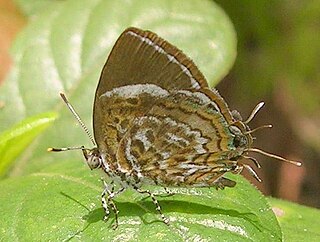
The Horagini are a small tribe of butterflies in the family Lycaenidae. Ahmetia, sometimes placed here, rather seems to belong to the Cheritrini however, but these are probably the Horagini's closest living relatives.
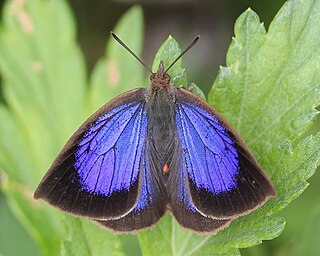
Arhopala is a very large genus of gossamer-winged butterflies (Lycaenidae). They are the type genus of the tribe Arhopalini. In the relatively wide circumscription used here, it contains over 200 species collectively known as oakblues. They occur from Japan throughout temperate to tropical Asia south and east of the Himalayas to Australia and the Solomon Islands of Melanesia. Like many of their relatives, their caterpillars are attended and protected by ants (myrmecophily). Sexual dichromatism is often prominent in adult oakblues.

The Mesosemiini are one of the tribes of metalmark butterflies. They are the basalmost living tribe of the Riodininae, outside the main radiation together with the slightly more advanced Eurybiini.

The Eurybiini are a small tribe of metalmark butterflies. They are one of the basal tribes of the Riodininae, outside the main radiation but not quite as primitive as the Mesosemiini. Though numerous Riodinidae genera have not yet been unequivocally placed in a tribe and the genus list is thus preliminary, it is not very likely that many other genera will end up being assigned here.

Castalius is a butterfly genus in the family Lycaenidae. They are commonly known as Pierrots. This name is also often used for the very closely related genus Tarucus.
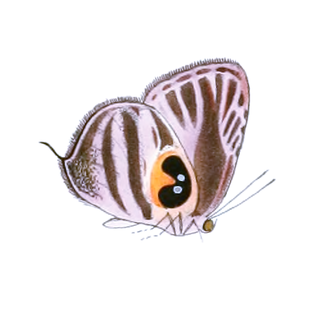
Enos is a genus of gossamer-winged butterflies. Among these, it belongs belong to the tribe Eumaeini of the subfamily Theclinae. These small butterflies occur essentially all over the Neotropics.

Lamasina is a genus of gossamer-winged butterflies ; the validity of its name is subject to dispute. Among its family, these sexually dimorphic Lepidoptera belong to the tribe Eumaeini of the subfamily Theclinae. Lamasina species are found mainly in northern South America, approximately to the Guyanas. L. draudti is also found in Central America south of the Yucatán Peninsula. In the Andes, the genus extends somewhat further south; L. rhaptissima almost reaches Bolivia.
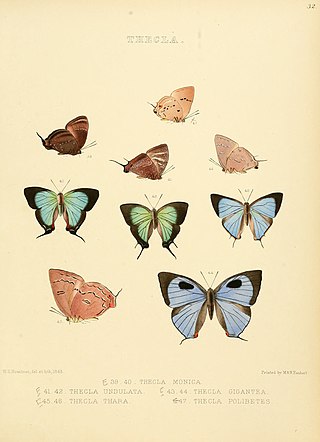
Megathecla is a gossamer-winged butterfly genus of tribe Eumaeini in the subfamily Theclinae. These butterflies are found in the Neotropical realm. The distinctness of this genus was only recognized after the year 2000, even though the type species M. gigantea has been scientifically known since the late 19th century.

Phengaris is a genus of gossamer-winged butterflies in the subfamily Polyommatinae. Commonly, these butterflies are called large blues, which if referring to a particular species is P. arion, a species resident in Europe and some parts of Asia.

Salazaria is a gossamer-winged butterfly genus of tribe Eumaeini in the subfamily Theclinae. As far as is known, these butterflies occur in the northern Andean region around Ecuador.
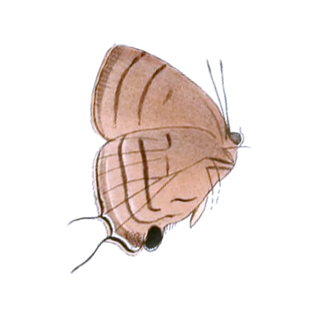
Theritas is a genus of gossamer-winged butterflies found in the Neotropics. Among the tribe Eumaeini of its subfamily Theclinae, it is usually placed in the group around the genus Atlides. In particular, it seems most closely related to Arcas.
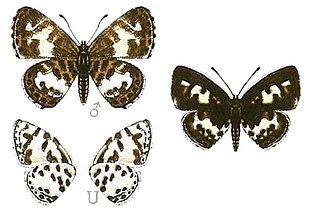
Tuxentius is a butterfly genus in the family Lycaenidae. They are commonly known as pied Pierrots or pies. Contained in this genus are the African species formerly placed in Castalius, except the blue-eyed Pierrot which is separated in Zintha.
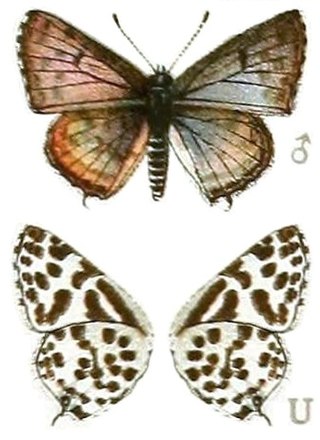
Zintha is a butterfly genus in the family Lycaenidae. It is monotypic, with the only species being Zintha hintza, the blue-eyed Pierrot, blue pied Pierrot or Hintza blue. The pied Pierrots proper are the closely related genus Tuxentius, however, and like Zintha they were formerly included in Castalius.

Ahmetia achaja is a species of butterfly in the family Lycaenidae. It belongs to the monotypic genus Ahmetia, formerly known as Cowania. It is sometimes assigned to the tribe Horagini, but it is more probably a member of the closely related Cheritrini. It is found in Thailand and Vietnam.

The Achlyodidini are a tribe in the skipper butterfly subfamily Pyrginae. Many species of them are notable for their gaudy colors and the unusually-shaped wings, which look as if the forewing tips have been squarely cut off. They are only found in the Americas, with few occurring out of tropical areas.
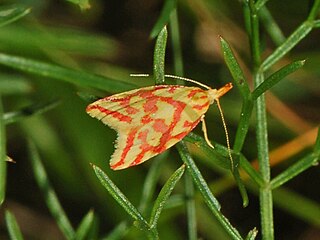
The Amphisbatinae was a small subfamily of moths in the superfamily Gelechioidea. Like their relatives therein, their exact relationships are not yet very well resolved. The present lineage is often included in the Depressariinae as a tribe Amphisbatini, though more often within the context of a "splitting" approach to Gelechioidea systematics and taxonomy, wherein the Depressariinae are elevated to full family rank and the Amphisbatinae are treated as a subfamily therein. An even more extremely split-up layout even treats the Amphisbatinae as full family Amphisbatidae. In the scheme used here, the Amphisbatinae are included in the Oecophoridae as a subfamily alongside the Depressariinae.



















